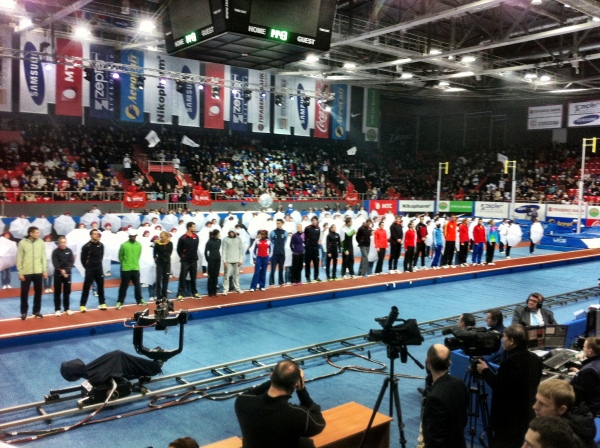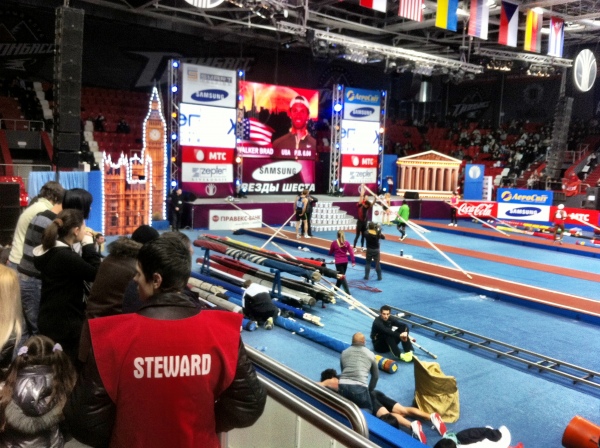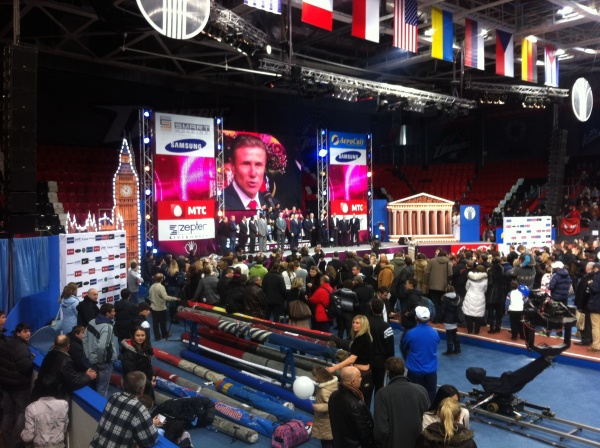Where Track and Field is Sexy and Knows it
By Alan Abrahamson | 2/22/12 |
DONETSK, Ukraine — In his time, it was enough that Roger Bannister broke the four-minute mile. People cared, and a lot. Back then, track and field mattered.
In their day, the likes of Edwin Moses, Carl Lewis, Florence Griffth-Joyner and Jackie Joyner-Kersee could just run fast and jump far. A great many people found track and field itself relevant and interesting.
Now, track and field lives on the margins of professional sport, especially in the United States, except for one week every four years at the Summer Olympics, when it commands Super Bowl-like attention. As ratings and attendance figures at other times have demonstrated conclusively, it’s not enough anymore to just to run and jump — or even throw.
So when Kylie Hutson, a rising American pole vaulter, took her runs Saturday night here at the 23rd annual running of the “Pole Vault Stars” to the strains of LMFAO’s “Sexy and I Know It,” playing to the crowd because she’s sexy and she knows it — hey, it was showtime.
Brad Walker, the 2007 world champion, ran the runway to perhaps the one G-rated sentence in the song “Move Bitch” from Ludacris. The noise shook the roof. The crowd roared.
Traditionalists may cringe. But this is the direction track and field inevitably has to move, a combination of sport and entertainment, if it wants to engage the paying public.

The Druzhba sports hall in Donetsk holds roughly 4,000. To get there, fans had to brave temperatures of minus-20 centigrade, or minus-4 Fahrenheit. The place was packed; at the start, the lines at the concession stands were three deep. The show went on for three hours, the vaulters going off on brown runways set off against a blue background, one of the guys, then one of the women, at the height of the action a vaulter going off every 90 seconds, all the time the music kicking. For three solid hours the Druzhba was an all-in track-and-field house party.
Generally, a standard-issue track meet comes off like an out-of-control circus. For the average fan, there’s too much going on, all of it seemingly at one time. The genius of an event like Pole Vault Stars is that it’s a break-out deal, pole-vaulting only; there aren’t any competing distractions on a surrounding track; moreover, you don’t have to be a track and field geek to understand what’s going on.
That’s what makes the concept so easily transferrable:
Why not lithe female high jumpers in Las Vegas? Studly male shot putters in downtown Manhattan? (On Wall Street?) Why not street races down Michigan Avenue in Chicago or Bourbon Street in New Orleans?
In England, they already hold a street race in Manchester. At the Diamond League meet in Zurich last September, the shot put events — men’s and women’s — were held in the entrance hall of the main train station.
Track and field has to think like this, out of the box, to get to the ultimate goal: to make the sport once again not only relevant and interesting to the average fan. That is, must-see. For American supporters, the aim has to be to pack a place like Cowboys Stadium — with that big-screen TV — by the 2020 or 2024 U.S. Olympic Trials, and one day to bring the world championships to the United States.
It can be done. Usain Bolt has shown that there is space in a crowded sports landscape for a single track and field personality.
At the same time, there is much to overcome.
Moving beyond the sport’s well-documented doping issues — for decades, track and field has ceded the show to other sports.
The NBA, for instance, is Jack Nicholson and Spike Lee and, to invoke the legendary voice of Lawrence Tanter announcing the obvious between breaks at Staples Center, Laker Girls.
Name even one celebrity associated with recent editions of the U.S. Olympic track trials — or, for that matter, the U.S. track and field season.
Still waiting …
During the Major League Baseball season, they put on sausage races at Miller Park in Milwaukee, and people care. No, really! They care so much that “Famous Racing Sausages” is trademarked.
The NFL, of course, offers up military flyovers and cheerleaders and, at the Super Bowl itself, the halftime rock-and-roll spectacle. Why wouldn’t track and field want to be more like the NFL?
Or, for that matter, the UFC?
Who, a few years ago, had even heard of the UFC?
“Look at the UFC and what Dana White has done. He has marketed the hell out of his athletes,” Walker said here late Saturday night. “We have tremendous athletes. Nobody knows who any of us are.”

Added Jeff Hartwig, the 1996 and 2008 Olympian who was in Donetsk representing Hutson, “You can make the general public fall in love with you if you put money and time into it, and we,” meaning track and field, “don’t do either.”
Track and field’s credibility as a would-be major sport is not just limited to the United States — though it is there that it may be most on the line. As just one example: The Millrose Games moved out of Madison Square Garden. Meanwhile, a number of European indoor meets this winter disappeared, including the seeming fixture in Stuttgart.
Mind you — this is an Olympic year.
“A lot of competitions are dead,” said Germany’s Björn Otto, who finished a strong second here.
He added at a news conference, referring to Pole Vault Stars, “We need these competitions. It’s promoting track and field as attractive for the world. And spectators can see that.”
This meet began in 1990, started by Sergey Bubka, the 1988 Seoul Games pole-vault gold medalist who went to high school in Donetsk. “For me,” Bubka said, “we must offer sport as a combination — with excitement, sport as a show. It gives a different impact. When you do this, the people love it.”
Bubka is now a vice-president of track and field’s international governing body, the International Assn. of Athletics Federations, and is on a short list of those believed to be positioning themselves for the succession — whenever it might occur — of the elderly IAAF president, Lamine Diack. Bubka is also an International Olympic Committee member and president of the national Olympic committee of Ukraine.
Asked if the pole-vault meet might be a play to advance his political interests, Bubka demurred. “What kind of promotion for myself? I didn’t need that. I dreamed to do well, to promote my city. It was Soviet times. It was my dream to give the people two to three hours of entertainment.”
Which has shown staying power. Samsung has become the title sponsor. Coca-Cola and others are also in, their executives saying they were happy to be on board because the Donetsk event delivers a family friendly audience.
Bubka, meanwhile, is forever tinkering with the format: “It’s my baby and every year we try to do something different.”
The show Saturday night featured mock-ups of both the Parthenon and Big Ben, tributes to the Olympic Games’ Greek heritage and this summer’s London Games, and a dance-number opening ceremony.
In all, 24 athletes took part, including the two Americans.
There were vaulters from Cuba, Brazil and all over Europe. Each of the vaulters got to choose his or her own music. Four picked the French artist David Guetta; in a sign of the opportunity just waiting there, virtually everyone else chose an American artist or a U.S.-based musical act, the choices ranging from Eminem to Rihanna to Jennifer Lopez.

This was a no-slouch field.
Renaud Lavillenie of France, the 2009 and 2011 world championships bronze medalist, won the men’s competition at 5.82 meters, or 19 feet, 1 inch. Otto, recovering from Achilles’ injuries, made the same height but took second on count backs.
Germany’s Malte Mohr, the 2010 world indoor silver medalist, came in third.
In recent years, Russia’s Yelena Isinbayeva, the Beijing 2008 gold medalist, had ruled the women’s competition in Donetsk — indeed, setting eight world records here from 2004 to 2009. She was a no-show this year, having jumped at a meet just three days before in Bydgoszcz, Poland — going 4.68, or 15-4 1/4.
That opened it up for Jiřina Ptáčníková of the Czech Republic, fifth at the 2010 world indoors, who jumped 4.70, or 15-5, a personal-best and a national indoor record.
“I like music,” she said afterward. “It’s special — to have a track and field meeting set to music is special.”
Cuba’s Yarisley Silva, her silver navel piercing shaking with every step, took second, at 4.60, or 15-1, also a national record. Hanna Shelekh, a local, just 18, the third-place finisher at the Singapore 2010 Youth Games, took third Saturday, also at 4.60, a Ukrainian record.
Hutson finished fifth in the women’s competition at 4.50, or 14-9; Walker, sixth in the men’s field at 5.62, or 18-5 1/4.
“When you see its in person, you see how successful it can be,” Walker said afterward, “it clicks.”

COMMENTS